Examining the Main Properties of a “Meso-Scale” Torsional Flutter Harvester in Gusty Winds
Abstract
:1. Introduction
1.1. Literature Review and Motivation
1.2. Brief Description of the Apparatus
1.3. Overview of Previous Studies
1.4. Study Objectives
2. Modeling Background
2.1. Dynamic Post-Critical Regime
2.2. Stochastic Differential Vector-Equation and Numerical Solution by Monte-Carlo Methods
2.3. Output Power Estimation
3. Description of the Apparatuses
4. Discussion of the Results
4.1. Reference Output Power Configuration
4.1.1. Duffing Restoring Torque Mechanism
4.1.2. Hybrid Duffing–van der Pol Restoring Torque Mechanism
4.2. Modified Configuration to Enhance Output Power
5. Conclusions
5.1. Summary
5.2. Main Findings
- The second configuration in Table 1, “Ty.2”, appears to be the most versatile and engaged by angular vibrations across all the various scenarios that have been examined. Output energy is often one order of magnitude larger than other configurations; for example, refer to Figure 2b versus Figure 4b. The “Ty.0” potentially becomes a viable alternative at high turbulence intensities and if and only if the hybrid Duffing–van der Pol mechanism is considered (e.g., Figure 5b).
- Flow turbulence tends to have a positive effect on the vibration onset by preceding the occurrence of angular motion, especially for “Ty.2” apparatus (Figure 2a versus Figure 4a). The operational range of the “Ty.2” harvester increases contingent on a reduction of mean wind speed by about . Nevertheless, the latter beneficial effect is observed at large turbulence intensities () that are possible in an urban wind exposure.
- For a hybrid Duffing–van der Pol torque mechanism, a nonlinear damping coefficient is recommended. Although moderate, post-critical flapping amplitudes (below ) are desirably enforced to avoid flow separation from the surface of the blade-airfoil, this range of amplitudes does not guarantee a notable effect on the performance.
- Larger values of in the hybrid Duffing–van der Pol torque mechanism are theoretically unrealistic [29] since they may be accompanied by larger angular flapping amplitudes that are more difficult to achieve; energy redistribution in the hybrid device reduces the energy transferred to the eddy current system, by dissipation term in the function . This loss is noticeable, for example, in Figure 5b, compared to Figure 4b where the apparatus is equipped with a cubic Duffing setup only. Design of a hybrid harvester is discouraged.
- The study investigated the influence of electro-mechanical coupling and generalized impedance () on the harvester’s output power across various configurations. Section 4.2 reveals the crucial role of the impedance on the electro-motive torque that couples with the aeroelastic torque in Equation (1). A noteworthy increment of output power is observed in Figure 7b, equal to about one Watt, which is a promising result.
5.3. Outlook
Funding
Institutional Review Board Statement
Informed Consent Statement
Data Availability Statement
Acknowledgments
Conflicts of Interest
Nomenclature
| Roman Symbols | |
| Aspect ratio of the blade-airfoil | |
| a | Dimensionless position of the pivot “O” |
| Scalar Wiener noise for turbulence | |
| Scalar Wiener noise for load perturbation | |
| b | Half-chord width of the blade-airfoil |
| Mean value of random (exponent) parameter: | |
| I | Output current of the power system (A) |
| Polar mass moment of inertia of flapping foil about “O” (kg×m2 ) | |
| Reduced frequency, one-DOF flapping foil | |
| Impedance of output power circuit (Henries) | |
| ℓ | Span-wise length of the blade-airfoil |
| Aeroelastic torque (Nm) | |
| Electromotive torque (Nm) | |
| Diffusion matrix of load perturbation | |
| Nonlinear drift vector-function (drift) | |
| Resistance of output power circuit (Ohms) | |
| t | Time (s) |
| Nonlinear turbulence diffusion function | |
| U | Mean wind speed (m/s) |
| Along-wind stationary turbulence (m/s) | |
| Normalized along-wind stationary turbulence | |
| Random state vector | |
| z | Vertical axis coordinate |
| Greek Symbols | |
| Flapping angle of the blade-airfoil, about “O” | |
| Nonlinear dimensionless damping (van der Pol) | |
| Zero-mean Gaussian random perturbation about | |
| Normalized inertia parameter | |
| Structural damping ratio of the flapping foil | |
| Nonlinear restoring torque function | |
| Three-dimensional load & flow effect parameter | |
| Dimensionless induced current, power circuit | |
| Dimensionless cubic torsional stiffness (Duffing) | |
| Second moment Lyapunov exponent | |
| Generalized impedance of the power circuit | |
| Aeroelastic state () | |
| Aeroelastic state () | |
| Standard deviation of | |
| Standard deviation of | |
| Dimensionless time | |
| Discrete time instant used to find 2MLE | |
| Sub-vector of state vector | |
| Unsteady aeroelastic forcing function at | |
| Dimensional electro-mechanical coupling coeff. (N/A) | |
| Electro-mechanical coupling coefficient | |
| Angular vibration frequency (rad/s) | |
| Pulsation of the one-DOF flapping foil (rad/s) | |
| Abbreviations and Operators | |
| DOF | Degree of freedom |
| Expectation operator | |
| T | Transpose operator |
| 2MLE | Second-moment Lyapunov exponent |
References
- Priya, S.; Inman, D.J. Energy Harvesting Technologies; Springer Science: New York, NY, USA, 2009. [Google Scholar]
- Young, J.; Lai, J.C.S.; Platzer, M.F. A review of progress and challenges in flapping foil power generation. Prog. Aerosp. Sci. 2014, 67, 2–28. [Google Scholar] [CrossRef]
- Hau, E. Wind Turbines: Fundamentals, Technologies, Application, Economics, 3rd ed.; Springer: Berlin/Heidelberg, Germany, 2013. [Google Scholar]
- Ali, S.; Lee, S.M.; Jang, C.M. Techno-economic assessment of wind energy potential at three locations in South Korea using long-term measured wind data. Energies 2017, 10, 1442. [Google Scholar] [CrossRef]
- Ali, S.; Lee, S.M.; Jang, C.M. Forecasting the long-term wind data via Measure-Correlate-Predict (MCP) methods. Energies 2018, 11, 1541. [Google Scholar] [CrossRef]
- Ali, S.; Jang, C.M. Effects of tip speed ratios on the blade forces of a small H-Darrieus wind turbine. Energies 2021, 14, 4025. [Google Scholar] [CrossRef]
- Ali, S.; Park, H.; Noon, A.A.; Sharif, A.; Lee, D. Accuracy testing of different methods for estimating weibull parameters of wind energy at various heights above sea level. Energies 2024, 17, 2173. [Google Scholar] [CrossRef]
- Ali, S.; Park, H.; Lee, D. Structural optimization of Vertical Axis Wind Turbine (VAWT): A multi-variable study for enhanced deflection and fatigue performance. J. Mar. Sci. Eng. 2025, 13, 19. [Google Scholar] [CrossRef]
- Kwon, S.D.; Park, J.; Law, K. Electromagnetic energy harvester with repulsively stacked multilayer magnets for low frequency vibrations. Smart Mater. Struct. 2013, 22, 055007. [Google Scholar] [CrossRef]
- Le, H.D.; Kwon, S.D. An electromagnetic galloping energy harvester with double magnet design. Appl. Phys. Lett. 2019, 115, 133901. [Google Scholar] [CrossRef]
- Bernitsas, M.M.; Raghavan, K.; Ben-Simon, Y.; Garcia, E.M.H. VIVACE (Vortex Induced Vibration Aquatic Clean Energy): A new concept in generation of clean and renewable energy from fluid flow. J. Offshore Mech. Arct. Eng. 2008, 130, 041101. [Google Scholar] [CrossRef]
- Singh, K.; Michelin, S.; de Langre, E. Energy harvesting from axial fluid-elastic instabilities of a cylinder. J. Fluids Struct. 2012, 30, 159–172. [Google Scholar] [CrossRef]
- Gkoumas, K.; Petrini, F.; Bontempi, F. Piezoelectric vibration energy harvesting from airflow in HVAC (heating ventilation and air conditioning) systems. Procedia Eng. 2017, 199, 3444–3449. [Google Scholar] [CrossRef]
- Petrini, F.; Gkoumas, K. Piezoelectric energy harvesting from vortex shedding and galloping induced vibrations inside HVAC ducts. Energy Build. 2018, 158, 371–383. [Google Scholar] [CrossRef]
- Kecik, K.; Mitura, A.; Lenci, S.; Warminski, J. Energy harvesting from a magnetic levitation system. Int. J. Nonlinear Mech. 2017, 94, 200–206. [Google Scholar] [CrossRef]
- Matsumoto, M.; Mizuno, K.; Okubo, K.; Ito, Y. Fundamental Study on the Efficiency of Power Generation System by Use of the Flutter Instability. In Proceedings of the ASME 2006 Pressure Vessels and Piping/ICPVT-11 Conference, Vancouver, BC, Canada, 23–27 July 2006; Volume 9, pp. 277–286. [Google Scholar] [CrossRef]
- Shimizu, E.; Isogai, K.; Obayashi, S. Multiobjective design study of a flapping wind power generator. J. Fluids Eng. 2008, 130, 021104. [Google Scholar] [CrossRef]
- Pigolotti, L.; Mannini, C.; Bartoli, G.; Thiele, K. Critical and post-critical behaviour of two-degree-of-freedom flutter-based generators. J. Sound Vib. 2017, 404, 116–140. [Google Scholar] [CrossRef]
- Boudreau, M.; Picard-Deland, M.; Dumas, G. A parametric study and optimization of the fully-passive flapping-foil turbine at high Reynolds number. Renew. Energy 2020, 146, 1958–1975. [Google Scholar] [CrossRef]
- Theodorsen, T. General Theory of Aerodynamic Instability and the Mechanism of Flutter; Technical Report NACA-TR-496; National Advisory Committee for Aeronautics: Washington, DC, USA, 1934.
- Eugeni, M.; Elahi, H.; Fune, F.; Lampani, L.; Mastroddi, F.; Romano, G.P.; Gaudenzi, P. Numerical and experimental investigation of piezoelectric energy harvester based on flag-flutter. Aerosp. Sci. Technol. 2020, 97, 105634. [Google Scholar] [CrossRef]
- Ahmadi, G. An oscillatory wind energy converter. Wind Eng. 1979, 3, 207–215. [Google Scholar]
- Roohi, R.; Hosseini, R.; Ahmadi, G. Parametric study of an H-section oscillatory wind energy converter. J. Ocean Eng. 2023, 270, 113652. [Google Scholar] [CrossRef]
- Caracoglia, L. Modeling the coupled electro-mechanical response of a torsional-flutter-based wind harvester with a focus on energy efficiency examination. J. Wind Eng. Ind. Aerodyn. 2018, 174, 437–450. [Google Scholar] [CrossRef]
- Smilg, B. The instability of pitching oscillations of airfoils in subsonic incompressible potential flow. J. Aeronaut. Sci. 1949, 16, 691–696. [Google Scholar] [CrossRef]
- Vakakis, A.F.; Gendelman, O.V.; Bergman, L.A.; McFarland, D.M.; Kerschen, G.; Lee, Y.S. Nonlinear Targeted Energy Transfer in Mechanical and Structural Systems (Part I); Springer: Dordrecht, The Netherlands, 2008; ISBN 978-1-4020-9130-8. [Google Scholar]
- Caracoglia, L. Stochastic stability of an aeroelastic harvester contaminated by wind turbulence and uncertain aeroelastic loads. J. Wind Eng. Ind. Aerodyn. 2023, 240, 105490. [Google Scholar] [CrossRef]
- Caracoglia, L. Stochastic performance of a torsional-flutter harvester in non-stationary, turbulent thunderstorm outflows. J. Fluids Struct. 2024, 124, 104050. [Google Scholar] [CrossRef]
- Caracoglia, L. Improving output power of a torsional-flutter harvester in stochastic thunderstorms by Duffing–van der Pol restoring torque. ASME J. Risk Uncertain. Part B 2024, 10, 041204. [Google Scholar] [CrossRef]
- Qin, Y.; Caracoglia, L. Turbulence and flapping pivot axis effects on torsional flutter harvester efficiency by closed-form formula. J. Wind Eng. Ind. Aerodyn. 2025, 256, 105938. [Google Scholar] [CrossRef]
- Pospíšil, S.; Náprstek, J.; Hračov, S. Stability domains in flow-structure interaction and influence of random noises. J. Wind Eng. Ind. Aerodyn. 2006, 94, 883–893. [Google Scholar] [CrossRef]
- Argentina, M.; Mahadevan, L. Fluid-flow-induced flutter of a flag. Proc. Natl. Acad. Sci. USA 2005, 102, 1829–1834. [Google Scholar] [CrossRef] [PubMed]
- Itô, K. On Stochastic Differential Equations. In Memoirs of the American Mathematical Society; American Mathematical Society: Providence, RI, USA, 1951; Volume 4, ISBN 978-0-8218-1204-4. [Google Scholar] [CrossRef]
- Wagner, H. Über die entstehung des dynamischen auftriebes von tragflügeln (in German). Z. Angew. Math. Mech. 1925, 5, 17–35. [Google Scholar] [CrossRef]
- Kloeden, P.E.; Platen, E.; Schurz, H. Numerical Solution of Stochastic Differential Equations Through Computer Experiments; Springer: Berlin/Heidelberg, Germany, 1994; ISBN 978-3-540-57074-5. [Google Scholar]
- Xie, W.C. Monte Carlo simulation of moment Lyapunov exponents. J. Appl. Mech. 2005, 72, 269–275. [Google Scholar] [CrossRef]
- Xie, W.C. Dynamic Stability of Structures; Cambridge University Press: New York, NY, USA, 2006. [Google Scholar]
- Grigoriu, M.D. Stochastic Calculus: Applications in Science and Engineering; Birkhäuser: Boston, MA, USA, 2002; ISBN 978-0-8176-4242-6. [Google Scholar]
- Jones, R.T. The Unsteady Lift of a Finite Wing; Technical Note NACA-TN-682; National Advisory Committee for Aeronautics: Washington, DC, USA, 1939.
- Roccia, B.A.; Verstraete, M.L.; Ceballos, L.R.; Balachandran, B.; Preidikman, S. Computational study on aerodynamically coupled piezoelectric harvesters. J. Intell. Mater. Syst. Struct. 2020, 31, 1578–1593. [Google Scholar] [CrossRef]
- Dunn, P.; Dugundji, J. Nonlinear stall flutter and divergence analysis of cantilevered graphite/epoxy wings. AIAA J. 1992, 30, 153–162. [Google Scholar] [CrossRef]
- Leimkuhler, B.; Matthews, C. Rational construction of stochastic numerical methods for molecular sampling. Appl. Math. Res. eXpress 2012, 2013, 34–56. [Google Scholar] [CrossRef]
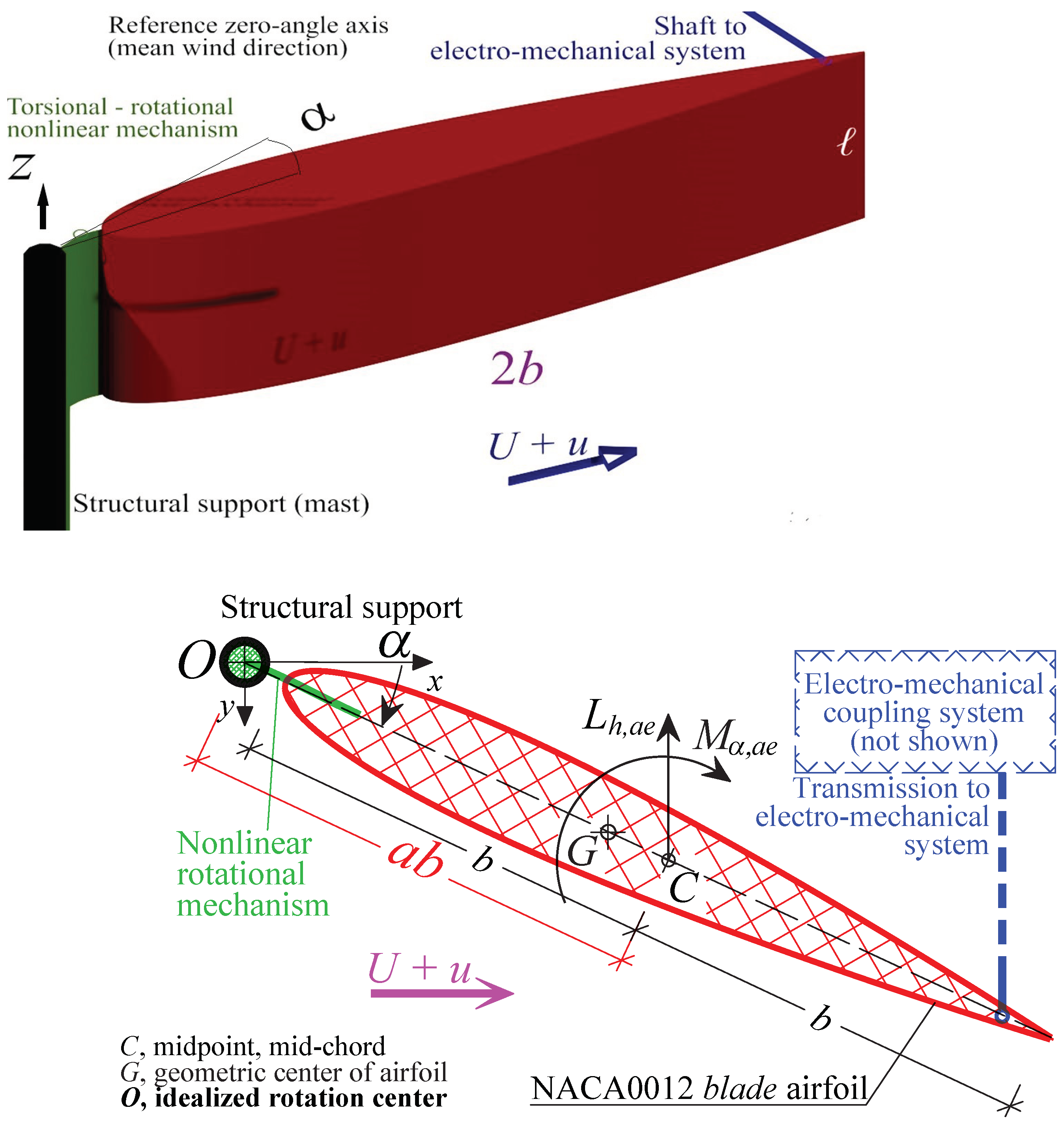
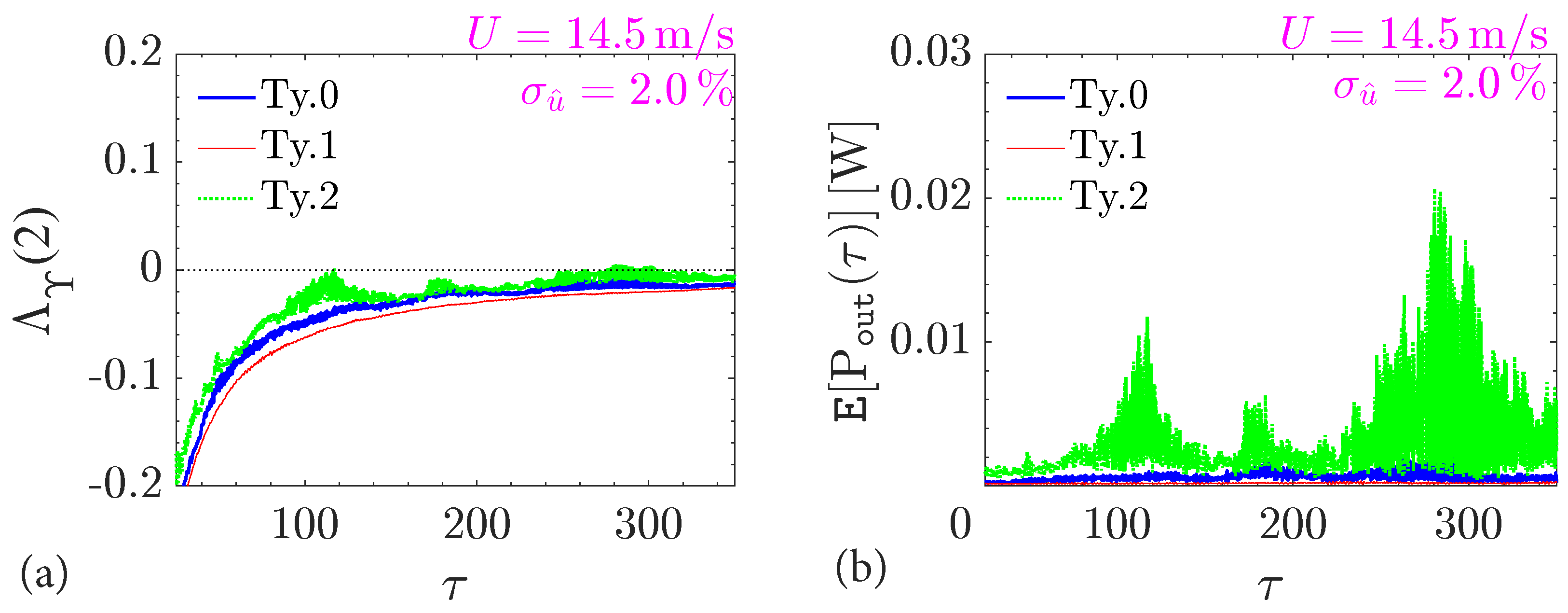
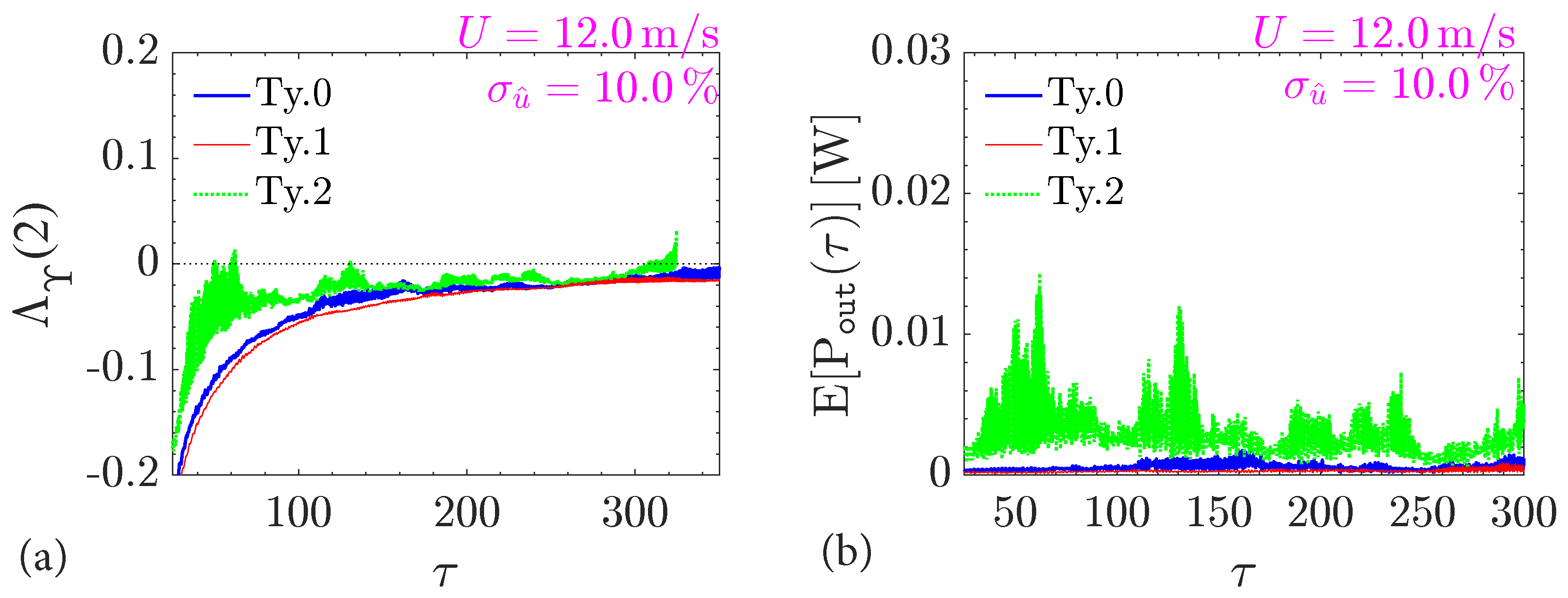
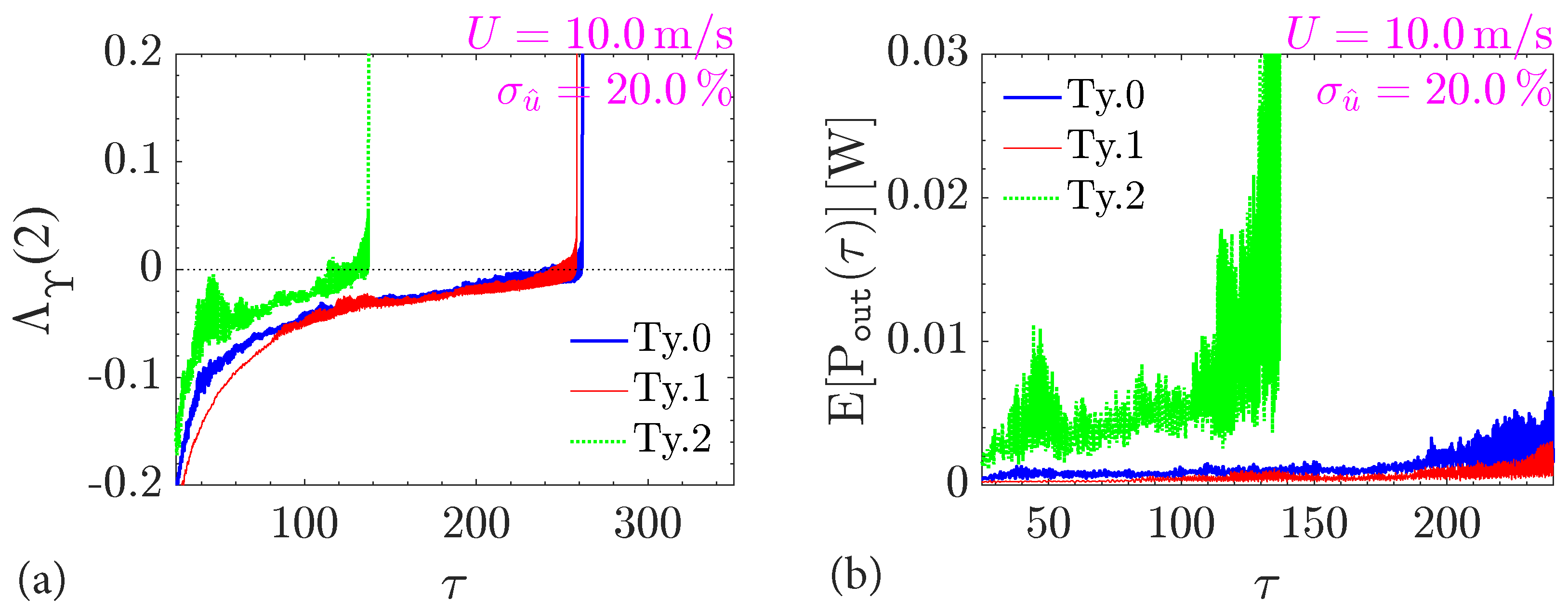


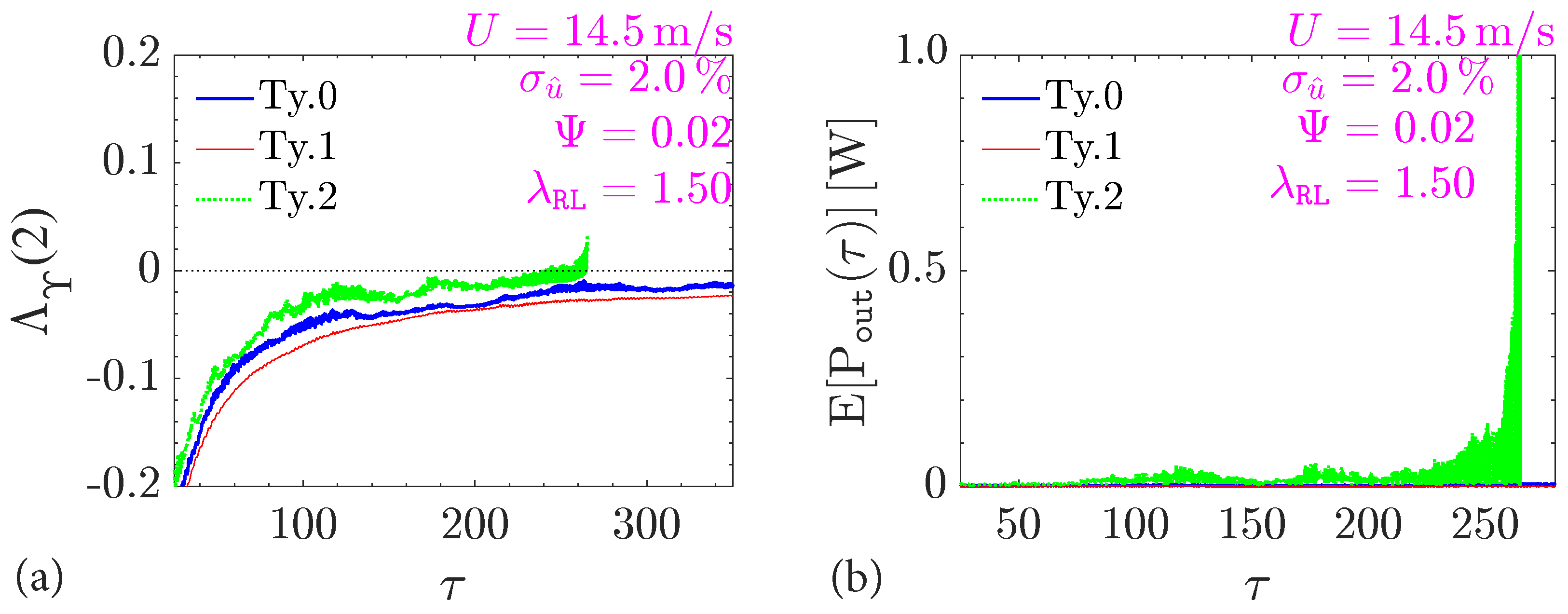
| Type | b | AR | |||||||
|---|---|---|---|---|---|---|---|---|---|
| (m) | () | (Hz) | (%) | (%) | |||||
| 0 [“Ty.0”] | 0.25 | 20 | 0.25 | 0.25 | 100 | {0, 0.5, 1} | 4 | {2, 10, 20} | 0.07 |
| 1 [“Ty.1”] | 0.25 | 40 | 0.25 | 0.30 | 100 | {0, 0.5, 1} | 4 | {2, 10, 20} | 0.07 |
| 2 [“Ty.2”] | 0.50 | 300 | 0.10 | 0.30 | 100 | {0, 0.5, 1} | 4 | {2, 10, 20} | 0.07 |
Disclaimer/Publisher’s Note: The statements, opinions and data contained in all publications are solely those of the individual author(s) and contributor(s) and not of MDPI and/or the editor(s). MDPI and/or the editor(s) disclaim responsibility for any injury to people or property resulting from any ideas, methods, instructions or products referred to in the content. |
© 2025 by the author. Licensee MDPI, Basel, Switzerland. This article is an open access article distributed under the terms and conditions of the Creative Commons Attribution (CC BY) license (https://creativecommons.org/licenses/by/4.0/).
Share and Cite
Caracoglia, L. Examining the Main Properties of a “Meso-Scale” Torsional Flutter Harvester in Gusty Winds. Wind 2025, 5, 10. https://doi.org/10.3390/wind5020010
Caracoglia L. Examining the Main Properties of a “Meso-Scale” Torsional Flutter Harvester in Gusty Winds. Wind. 2025; 5(2):10. https://doi.org/10.3390/wind5020010
Chicago/Turabian StyleCaracoglia, Luca. 2025. "Examining the Main Properties of a “Meso-Scale” Torsional Flutter Harvester in Gusty Winds" Wind 5, no. 2: 10. https://doi.org/10.3390/wind5020010
APA StyleCaracoglia, L. (2025). Examining the Main Properties of a “Meso-Scale” Torsional Flutter Harvester in Gusty Winds. Wind, 5(2), 10. https://doi.org/10.3390/wind5020010







